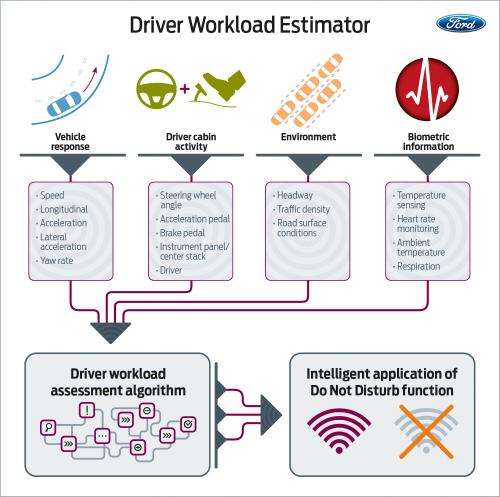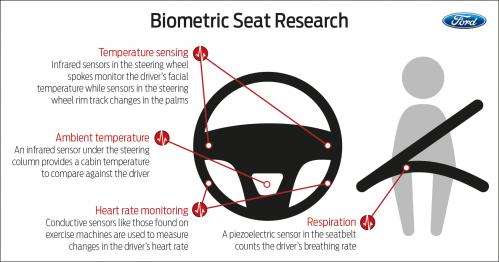June 28, 2012 report
Ford explores call turnoffs for stressed-out drivers

(Phys.org) -- No calls for you. That is the word from a new technology experiment by Ford, for stressed-out drivers who risk accidents by distractions from incoming calls, playing music, and other vehicle infotainment sources. Having to maneuver the vehicle in heavy traffic places demands on focused safe driving. Risks are compounded by distractions when coping with tricky ramp-merging scenarios or blind-spot monitoring or coping with other vehicles that are frequently changing lanes, for example. Ford this week performed a demo of its “Driver Workload Estimator” that will limit phone and text distractions when deciding that the driver’s stress levels call for safety intervention.
“With today's ever-increasing concern about driver distraction, engineers in the Ford Research and Innovation labs are developing ways to help the driver stay focused in busy situations by intelligently managing incoming communications,” said the company.

Outstanding features in its new foray into workload-estimating is in the range of sensors taking information from the driver’s body. There is a palm temperature sensor, heart rate monitor, and a sensor in the seatbelt to check a driver’s breathing rate. In the company’s press statement, Gary Strumolo, manager of vehicle design and infotronics, Ford Research and Innovation, said."Biometric or health information of the driver can help us better tailor the experience when behind the wheel."
Overall, the detectors would be using real-time data from throttle, brakes steering wheel, and seatbelt, and meshing it with information from sensors and cameras.
Ford is fundamentally working on an algorithm to create the estimator. So what good is all this monitoring, for what end? Based on the information received, the system then is designed to take steps to intervene and reduce distractions when the driver is under heavy stress. Ford says that “the car could intelligently apply the Do Not Disturb feature that is already available as part of MyFord Touch, helping the driver stay focused on the road during the high-demand situation.” Ford’s algorithm asks the question if the driver is stressed or driving into a high-stress situation. If the answer is yes, Ford says the car would trim back auxiliary systems and beef up other ones so that the driver would remain as focused as possible. The data would determine external demands placed on the driver at any time due to traffic and road conditions. Sensors would gauge physical states, such as a rise in heart rate.
The car would then “intelligently” filter out incoming calls. In lighter traffic and under safer conditions, the driver would then be allowed to field calls or get texts. The technology is still in research.
More information: media.ford.com/article_display … cfm?article_id=36728
© 2012 Phys.Org



















